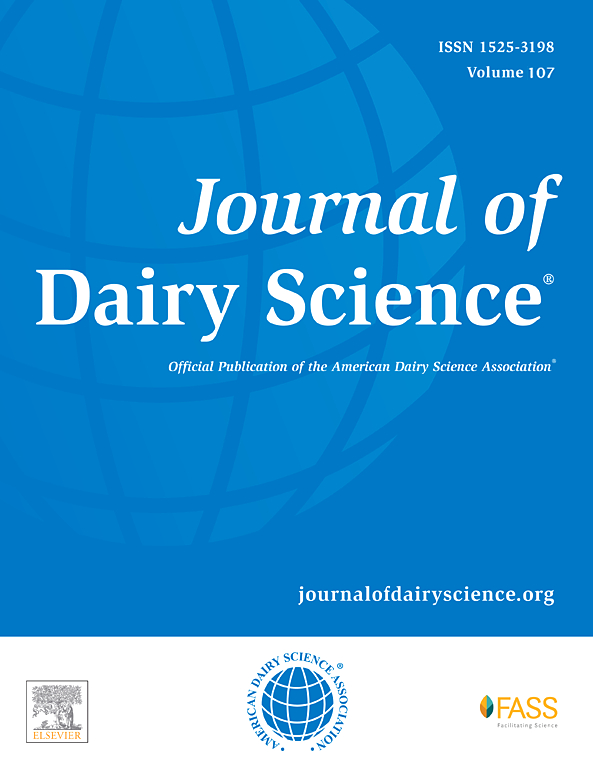The role of glutathione S-transferase mu 2 in mitigating fatty acid–induced hepatic inflammation in dairy cows
IF 3.7
1区 农林科学
Q1 AGRICULTURE, DAIRY & ANIMAL SCIENCE
引用次数: 0
Abstract
Fatty liver is a major metabolic disorder in perinatal dairy cows, characterized by elevated plasma concentrations of nonesterified fatty acids (NEFA) and hepatic inflammation. Glutathione S-transferase mu 2 (GSTM2), a phase II detoxification enzyme, regulates cellular antioxidant and detoxification processes in nonruminants. However, its involvement in NEFA-induced hepatic inflammation in dairy cows with fatty liver remains unclear. This study aimed to elucidate the role of GSTM2 in mediating hepatic inflammation caused by elevated NEFA levels in dairy cows with severe fatty liver. An in vivo study was conducted using 10 healthy cows (hepatic triacylglycerol [TG] content <1%) and 10 cows with severe fatty liver (hepatic TG content >10%), matched for the number of lactations (median = 3, range = 2–4) and DIM (median = 9 d, range = 3–15 d). Liver tissue and blood samples were collected before feeding. Compared with healthy cows, cows with severe fatty liver had higher plasma concentrations of NEFA, BHB, haptoglobin (HP), plasma amyloid A (SAA), and lower plasma concentration of glucose. These cows also showed significantly lower abundance of hepatic GSTM2 and overactivated hepatic inflammatory pathways, as indicated by increased abundance of phosphorylated inhibitor of κB (IκB)α and nuclear factor κB (NF-κB) p65, NLR family pyrin domain containing 3 (NLRP3), apoptosis-associated speck-like protein containing CARD (ASC), and caspase-1 (CASP1), as well as mRNA levels of tumor necrosis factor α (TNFA), IL6, and IL1B. In vitro, hepatocytes isolated from 5 healthy calves (1 d old, fasted female, 30–40 kg of BW) were used to determine the effects of GSTM2 on hepatic inflammation. First, hepatocytes were treated with NEFA (1.2 mM) for varying durations (0.5, 1, 3, 6, 9, 12, 15, or 18 h). The NEFA treatment significantly increased the phosphorylation of IκBα and NF-κB p65, protein abundance of NLRP3, ASC and CASP1, and mRNA levels of TNFA, IL6 and IL1B, peaking at 9 and 12 h. Second, hepatocytes were treated with different concentrations of NEFA (0, 0.6, 1.2, or 2.4 mM) for 9 h, which decreased GSTM2 protein and mRNA abundance. Meanwhile, GSTM2 was silenced using small interfering RNA or overexpressed using adenovirus for 48 h in hepatocytes, followed by NEFA treatment. Silencing GSTM2 augmented the NEFA-induced increase in phosphorylation of IκBα and NF-κB p65, as well as protein abundance of NLRP3, ASC and CASP1, and mRNA levels of TNFA, IL6 and IL1B. Conversely, overexpression of GSTM2 mitigated these inflammatory signals upon NEFA treatment. In summary, these findings indicate that GSTM2 plays a crucial role in modulating NEFA-induced hepatic inflammation. Targeting GSTM2 may offer new strategies to treat or prevent fatty liver disease in dairy cows.
脂肪肝是围产期奶牛的一种主要代谢紊乱,其特点是血浆中的非酯化脂肪酸(NEFA)浓度升高和肝脏发炎。谷胱甘肽 S 转移酶μ2(GSTM2)是一种 II 期解毒酶,在非反刍动物中调节细胞的抗氧化和解毒过程。然而,它在奶牛脂肪肝中参与 NEFA 诱导的肝脏炎症的情况仍不清楚。本研究旨在阐明 GSTM2 在介导严重脂肪肝奶牛 NEFA 水平升高引起的肝脏炎症中的作用。本研究使用 10 头健康奶牛(肝脏甘油三酯 [TG] 含量为 10%)进行了体内研究,这些奶牛的泌乳次数(中位数 = 3,范围 = 2-4)和DIM(中位数 = 9 d,范围 = 3-15 d)相匹配。饲喂前采集肝组织和血液样本。与健康奶牛相比,重度脂肪肝奶牛血浆中的NEFA、BHB、血红蛋白(HP)和血浆淀粉样蛋白A(SAA)浓度较高,而血浆葡萄糖浓度较低。这些奶牛的肝脏 GSTM2 丰度也明显较低,肝脏炎症通路过度激活,表现为磷酸化κB (IκB)α 抑制剂和核因子κB (NF-κB) p65 的丰度增加、NLRP3)、含 CARD 的凋亡相关斑点样蛋白(ASC)和 Caspase-1 (CASP1),以及肿瘤坏死因子α(TNFA)、IL6 和 IL1B 的 mRNA 水平。在体外,使用从 5 头健康小牛(1 天大,禁食雌性,体重 30-40 千克)分离的肝细胞来确定 GSTM2 对肝脏炎症的影响。首先,用不同持续时间(0.5、1、3、6、9、12、15 或 18 小时)的 NEFA(1.2 mM)处理肝细胞。其次,用不同浓度的 NEFA(0、0.6、1.2 或 2.4 mM)处理肝细胞 9 h,会降低 GSTM2 蛋白和 mRNA 的丰度。同时,使用小干扰 RNA 沉默 GSTM2 或使用腺病毒在肝细胞中过表达 GSTM2 48 小时,然后再处理 NEFA。沉默 GSTM2 会增加 NEFA 诱导的 IκBα 和 NF-κB p65 磷酸化、NLRP3、ASC 和 CASP1 蛋白丰度以及 TNFA、IL6 和 IL1B 的 mRNA 水平。相反,过表达 GSTM2 可减轻 NEFA 处理时的这些炎症信号。总之,这些研究结果表明,GSTM2 在调节 NEFA 诱导的肝脏炎症中起着至关重要的作用。以 GSTM2 为靶标可能会为治疗或预防奶牛脂肪肝提供新的策略。
本文章由计算机程序翻译,如有差异,请以英文原文为准。
求助全文
约1分钟内获得全文
求助全文
来源期刊

Journal of Dairy Science
农林科学-奶制品与动物科学
CiteScore
7.90
自引率
17.10%
发文量
784
审稿时长
4.2 months
期刊介绍:
The official journal of the American Dairy Science Association®, Journal of Dairy Science® (JDS) is the leading peer-reviewed general dairy research journal in the world. JDS readers represent education, industry, and government agencies in more than 70 countries with interests in biochemistry, breeding, economics, engineering, environment, food science, genetics, microbiology, nutrition, pathology, physiology, processing, public health, quality assurance, and sanitation.
 求助内容:
求助内容: 应助结果提醒方式:
应助结果提醒方式:


